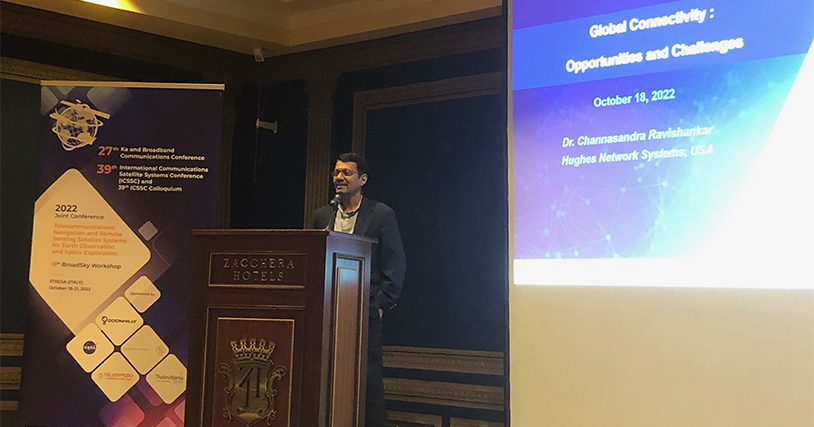
The focus for the 39th International Communications Satellite Systems Conference (ICSSC) Colloquium, co-chaired by my colleague Dr. Rajeev Gopal and held in Stresa, Italy in October, was satellite mega-constellations – those groups of hundreds or even tens of thousands of satellites covering a vast span of the globe. Satellites within mega-constellations are typically low (LEO) or medium (MEO) earth orbit systems. As one of this year’s keynote speakers, I shared some of the opportunities and challenges associated with these mega-constellations.
While these constellations are called “mega,” the fact is that no single transport—be it LEO, MEO, GEO or terrestrial—will satisfy the growing demand for global high speed, high quality, high security and high availability connectivity. To connect all things around the world, including planes, ships, trains, buses, smart cars, vehicles, equipment and more, multiple types of constellations will be necessary, making hybrid networking architecture essential. All domains must be integrated and employed to their fullest if we are to connect people anywhere and everywhere to anyone and everything.
But with the concurrent use of multiple mega-constellations comes interference among systems in the same frequency band. For these systems to co-exist, regulators set guidelines for how much interference is acceptable. The amount of interference is time-varying and depends on individual constellation parameters. During periods when interference is below a given threshold, the guidelines permit individual systems to fully utilize all of the assigned spectrum so that there is little impact on system capacity. During periods when interference is above a given threshold, guidelines recommend splitting the spectrum among individual systems so they no longer need to share resources. However, splitting the spectrum is a less than ideal solution as it reduces capacity by half when there are two systems and divides it into thirds when there are three. Reduced capacity would be deleterious to the individual operators and their business plans. The good news is that technologies and techniques exist to allow individual systems to maximally use all of the assigned spectrum and minimally split the spectrum.
One example is employing smart sidelobe suppression techniques to reduce the response pattern of an antenna in the direction of interferers and therefore lower perceived interference. As humans, we do this all the time when we have conversations in crowded and noisy environments. Our ears adapt and tune out background noise and distractions so we can concentrate on specific conversations. Machine learning (ML), artificial intelligence (AI) and antenna design can accomplish the same thing, enabling antennae to suppress interference coming from multiple directions.
When sidelobe suppression techniques cannot be used effectively, another option is alternate path selection—using software defined satellite networking (SDSN), which also relies on AI/ML, to predict cases of potential interference. AI algorithms then choose an alternate satellite link to eliminate or mitigate interference threats. Handovers can be done within a single constellation or across constellations. Hughes has successfully demonstrated these capabilities, showing real-time seamless connections between the JUPITER™ 2 GEO high-throughput satellite and OneWeb LEO systems, and between JUPITER 2 and a terrestrial cellular system.
Because no single system can meet the needs of all use cases, the future of connectivity is in multi-orbit, multi-domain, multi-service and multi-band architectures and technologies like these. They’ll help to deliver high throughput, high availability, high security and a quality connected experience for users everywhere around the world.